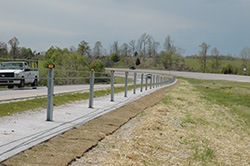Cable Barriers Provide Protection
by April 29, 2013 12:00 am 153 views

Drivers who have noticed recently installed cable median barriers between Tontitown and Siloam Springs can expect to see more of them in the near future.
Drivers who have grown accustomed to cable median barriers installed along certain stretches of Interstate 540, meanwhile, shouldn’t get too used to them. According to Arkansas State Highway and Transportation Department public information specialist David Nilles, the cable barriers along I-540 will be repurposed when some portions of the highway are widened to six lanes.
The eventual removal of the I-540 cable barriers, however, doesn’t represent a wavering in the AHTD’s commitment to expanding their implementation throughout the state. In fact, while Arkansas currently has just 92.5 miles of cable barriers in place, Nilles said the total is set to exceed 500 miles over the next three years.
The barriers’ primary function is to prevent vehicles from crossing medians and traveling into oncoming traffic. They are designed to redirect vehicles that strike them.
“They have a real good safety rate at preventing vehicles from crossing that median,” Nilles said. “Now, they’re designed for passenger vehicles and not for commercial vehicles like an 18-wheeler, but as far as what they’re designed for, they do a really good job.”
Head-on crashes account for about 40 percent of all roadway departure fatalities, according to the AHTD, or about 25 percent of all roadway fatalities. Additionally, the department estimates at least 10 lives per year will be saved due to the installation of the barriers.
A total of 10 miles between Tontitown and Siloam Springs will have the barriers, while 22.3 miles have been completed along I-540, with construction of another 4.9 miles under way.
Nilles said various factors are considered when determining where to install the barriers.
“We look at the history of different locations — how many crashes have occurred at that particular location, the traffic counts at that particular location and things like that — and that gives us a pretty good idea of what our priorities should be as far as installing these barriers,” he said.
The cost of the roughly 400 miles of barrier that will be added is about $75 million, the AHTD said, and is federally funded. That’s a cost of about $187,500 per mile.
The projects in Northwest Arkansas have cost about $206,000 per mile. According to the AHTD, they break down as follows:
• Collins & Hermann Inc. of St. Louis completed the 22.3 miles along I-540, and was paid $4.9 million.
• Nationwide Construction Group of Chesterfield, Miss., is working on the 4.9-mile project still under construction, and will be paid $1.3 million.
• Eaton Excavating Inc. of Harrison is constructing the 10-mile project along U.S. 412, for a price of $1.49 million.
Nilles said the barriers, which are made of steel, are “pretty much a new safety concept in Arkansas,” but are used widely not just in other parts of the United States, but around the world.
He also said repair and maintenance costs are “pretty minimal and can be done pretty quickly,” particularly when compared to concrete barriers.
Nilles said a two-man crew can go out “for an hour or two” and make the necessary repairs to a damaged cable barrier. The posts are collapsible, so the repair essentially entails resetting the post and then restringing the cable.
Repairing or replacing a concrete barrier, conversely, is a lengthier process. For starters, equipment has to be brought in just to move the barrier and start the process of replacing it.
Nilles said the reason concrete barriers will be installed along parts of I-540 is because the widening will be done “on the inside as opposed to the outside of the roadway.”
Otherwise, drivers can expect to see more cable barriers along four-lane highways throughout the state.
“I wouldn’t say you’ll them along every mile, but our No. 1 priority here at the highway and transportation department is safety,” Nilles said, “so if we find a stretch of road that needs them, we’re going to do everything we can to get them in place.”
